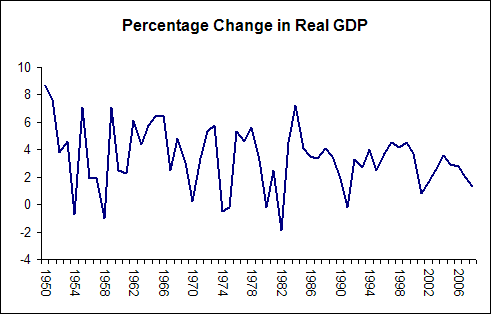Social Security & Medicare: Don’t Worry Be Happy
In response to my last post on Social Security, Medicare and the medium to long term fiscal outlook for the U.S. Bernard Finel has another response. In this post Bernard looks at the deficits from 1950 to 2007 and writes, in part,
(Warning: Biiiiig Post Below the fold.)
And indeed, a shallow assessment of the federal budget supports Steve’s argument. After all, from 1950 to 2007, the budget was in deficit 50 times and only ran 9 surpluses.
[…]
So, at first glance, Verdon has a point. 85% of U.S. federal budgets since 1950 have been in deficit, and we are looking at addition deficits from 2008 to 2015 at a minimum. But is a “deficit” the best measure of an improvement or decline in the fiscal position of the nation?
I can’t help but feel that this response is to my comment in this post replying to something Bernard wrote. Bernard wrote,
But, even in the worst case scenario, Social Security never runs a deficit of worse that 2% of GDP in any given year even out 75 years. In short, Social Security, by itself, won’t bankrupt the country. If the rest of the budget was in balance, even in the worst years, paying for the Social Security shortfall out through pure deficit spending would actually reduce our net debt burden over time due to normal economic growth.–emphasis added
I replied that I thought that was a wildly optimistic assumption since in looking at the last 50 to 60 years we see that most of the time our government runs a deficit. To this Bernard runs to the historical data and pronounces me silly since many of those deficits during that time frame were small. He is right that many of those deficits were small (as a ratio of GDP and in some cases even in absolute terms). However Bernard has made an implicit assumption: that the next 20 years or so will, from a budgetary stand point, look like the 1950s and 1960s.
I think this is an overly optimistic assumption. Why? Because we are going into a very bad recession which even absent stimulus spending is going to drive up our deficits and debts. For example, not too long ago I linked to this article by Carmen Reinhard and Kenneth Rogoff that talks specifically about recessions that arise due to financial crises. One thing Reinhard and Rogoff note is the following,
Perhaps the most stunning message from crisis history is the simply staggering rise in government debt most countries experience. Central government debt tends to rise over 85% in real terms during the first three years after a banking crisis. This would mean another $8 trillion or $9 trillion in the case of the U.S.
In other words, Bernard’s look at the historical data is largely irrelevant. I should point out that I do forecasting as my day job. The kind of analysis that Bernard does isn’t bad, but it is rudimentary to the stuff I do. And yes, I rely on historical data. However, there are times when I and those I work with know that the historical data are not going to provide a good indicator of what the future will be. Here is an example from my work. A rate option open to customers is now closed. Existing customers can remain on the rate, but if they move they lose the option and new customers cannot get the option either. Prior to this change the number of customers on this rate option was rising at a steady pace of say 20 to 30 thousand a year. Should we expect this trend to hold given the historical data and more importantly what we know about the rate schedule being closed? Absolutely not. We’d expect a slow decay in the number of customers on that rate option. So I can’t just look at the historical data and use that as a guide as to what to expect from the future.
We have good reason to believe that the financial crisis and the recession are going to cause large deficits for a number of years and come close to doubling our national debt. And to be frank, I think I’m going to go with the Harvard and University of Maryland professors who have made it a significant part of their life to study this topic than with the expert in international security issues.
Further more, as Bernard has agreed, we have a serious problem with the growth rate of health care costs. Health care costs are growing at a rate that is 2 to 2.5 percentage points higher than GDP. To be clear on this, if GDP grows at 2% health care costs will grow at 4% to 4.5%. Clearly this is unsustainable. Further, the revenues for the entire budget are likely to grow at the rate of GDP, in other words we will eventually have far more in commitments than we do resources. So this too will result in a budget/deficit/debt situation that is not like the 1950s and the 1960s.
In short, Bernard’s appeal to the historical data is based on a faulty recollection of why I brought up the issue of the high frequency of deficits in the past—i.e. it was to show that politicians often do not have the stomach to be fiscally restrained and in fact, one could argue that the opposite is true, that politicians have an incentive to fiscally irresponsible. Further, taking into consideration where we are today, it does not seem like the 1950s and 1960s are going to be even a remotely close proxy to our fiscal situation for the next 20 years.
So when I consider the above I see a serious problem in the not too distant future. The U.S. is or has borrowed and will likely increase borrowing to such an extent that investors in U.S. government debt may become worried about the ability to repay that debt. After all what do you do if a sovereign nation declares that it isn’t going to pay on its debt obligations in one form or another? Invade? Send a collection agency after them? Sure it would be bad for the country that does this, but it would also be bad for holders of that country’s debt. So if this happens the U.S. might have to offer debt at a higher interest rate. What is the implication of this? Well all investment projects that are no lower than the new higher interest rate for government debt will be crowded out. In other words, investment goes down. Investment is really what drives growth in the future. You spend money now so you can have even more in the future. With less investment today we’ll have lower growth in the future. And this is one of Bernard’s key assumptions: that growth in the future will be like it was in the past.
[Aside: Does anyone get the impression Bernard is stuck in the 1950s and 1960s?]
But if one looks carefully at the rate of growth in GDP one will notice that it has been steadily declining. Not a lot, but it is there in the data. Basically the peaks of the business cycle have become less high. The business cycle has flattened out to some extent. One can argue about why, but the empirical finding is that this is case. So when Bernard calls assuming GDP growth is 2% on average for the next 50 years is mind bogglingly pessimistic, to one who has been reading the literature on this (that would be me) it isn’t so pessimistic. It appears to be the case.
[Technical Note: For example, if one were to download the percentage change in GDP from the NIPA tables at the BEA and include a trend variable as well as a recession dummy variable the resulting regression explains about 31% of the variation observed in the data and the trend and recession dummy are both statistically significant and negative. In other words, economic growth rates are declining, and no it isn’t just a function of the low GDP numbers from recent data.]
We can see this in the data in the following graph:
And this brings up another curious point that Bernard uses to support his claim that there is no reason to even consider making changes to Social Security. He argues it is quite sustainable by itself as is.
And the elderly population is slated to grow by about 2% a year from now until, I believe, something like 2045. (I will post full details shortly.) It varies from year to year of course, but the average increase is 2%. So… if you assume that the economy grows at 2% per year, then then social security should cost about what it does now.
In other words, if GDP increases by 2% and the elderly population increases by 2% then what’s the big deal? Everybody else out there working will just have to make do from now until 2045 with no additional shares of the increased GDP. Lets not worry about the implications of short terms losses in GDP (by short term think the next several years of below potential growth) and with Medicare eating up a larger and larger portion of GDP. And the significant portion of the budget is going to have to go towards servicing the debt.
And finally we have this rather smug condescension,
With all due respect… I don’t think you fully understand how the CBO does projections.
But look… can we use common sense here? The CBO projection for Medicare and Medicaid is that it will eat up something like 16% of GDP. Right now, Medicare and Medicaid represent 1/3 of U.S. health care spending — the rest is private sector. Keep the ratios the same. Do you really think it is even possible for nearly 50% of GDP to be devoted to health care. Even if we do nothing about it… how is that possible? Yet, that is what the CBO projects will happen.
I’ve already noted that such trends as the CBO and other have noted for our fiscal outlook likely wont reach the point Bernard has noted above. In fact, it was in the post Bernard is replying too. I wrote a hypothetical example to show the problem with exponential growth rates that are out of synch,
However, there is a second cause. Health care costs have been rising at an unsustainable rate. Here is a simple exercise to show the problem. Suppose today you are spending $1 on health care and that you have $2 in income. Further you income grows at 3% per year and health care expenditures grow at 5% per year. How long until you can no longer afford health care? At about the 37 year mark your expenditures on health care is just about equal to your income. In short you’ll have no more money for food, housing, transportation, and entertainment. Clearly that is not sustainable. In reality, something would “give” well before you got to that point.
And it isn’t just me that Bernard is insulting here with his views, but all the economists at the CBO, the Urban Institute, the Brookings Institute, the Heritage Foundation and in various universities and such around the country. You see, there is a fairly broad agreement that our fiscal outlook is not good that spans the political spectrum. Where you get most of the disagreement is on how to deal with it. I have little doubt that most of the economists working on this are quite aware that things would likely not get to the point where 50% of our GDP goes towards health care let alone 100%. However, if you have a situation where if things were to hold on course and in say 45 years 100% of GDP would have to go towards some specific part of the economy…it really underscores that something is off the rails, no? What Bernard is asking for is what will happen in an economy where you have one sector using up GDP at a rate of 4% while GDP grows at 2%. Unfortunately that is a far, far more difficult question to answer than merely making some reasonable assumptions about certain parameters in a model and then projecting the outcome out 75 years. Such models would have to have all sorts of dynamic interaction effects which Bernard scorns as “being down in the weeds“. Yes, the interanational security expert is going to tell experts in an completely different field where they are doing it wrong.
To sum up, Bernard is using historical data that is unlikely to be a good indicator of the next 2 or more decades of in terms of economic growth and what the budgetary situation will look like. Further, he is ignoring the work of experts in the area of financial crises and the recessions that follow.






Jeff have you tried searching OTB using google? You are a little late, IMO.
I am insulting no one. My arguments are perfectly consistent with the projections of many analysts, and are ultimately — on Social Security in particular — more pessimistic than their “low cost” projections, though more optimistic than their “intermediate” ones. It is simply a lie that everyone agree with you and no one with me.
Further, the only insulting person has been you. You’ve called me stupid, innumerate, and now are scorning my professional credentials. I hold a Ph.D., have taught graduate research design, have writen on strategic planning and long-term trend analysis. I shouldn’t even have to say that…what difference does it make? Address my arguments if you want, but stop being insulting to me and my professional background.
What’s more, my arguments have been primarily about methods. If you want to project 30-40 years in the future, you need to use long-term trends macro trends because those are most stable. There is nothing insulting about that argument. CBO analysts do things I could never do professionally, but they are also committed to certain analytic techniques which are demonstrably problematic for long-term predictions.
What’s more you are using all sorts of different sources without any indications that you are considering their different purposes. So, studies that are designed to assess the specific programatic viability of Social Security are mixed with long-term political-economic assessments about the economic sustainability of it. All sorts of apples and oranges, but as long as they support your position, you are not even thinking about the underlying purpose or methods of the analysis. For all you sophistication, your arguments are nothing more than serial citation to whichever authorities happen to support your position. My arguments flow from an underlying methodological preference — which I have made clear. All you are doing is playing “stack the reports.”
Worse, you systematically misrepresent my approach. I have never focused on the 1950s, and indeed, have argued that our structural fiscal position changed in the 1980s and that those conditions probably still obtain.
Anyway, you are a rude and dishonorable person, and I am done talking to you.
If possible, I’d like someone to remove the last line of my previous post.
Steve is right, btw, that economic growth rates are likely slowing somewhat. I definitely overstated things when I said that assuming less than 2% GDP growth was mind-bogglingly pessimistic.
I can’t help myself…
Let’s transpose my approach to my own field, so that I can show that I am not claiming a superior intellect to anyone else.
Let’s say we wanted to predict the likely outcome of a conflict between the U.S. and China in the Taiwan Strait in 2030.
A security specialist might look at existing force structures, relative pace of technological improvements, trends in power projection, and so on. Such a specialist could build a very, very sophisticated model of how each country’s militaries might develop and linked to equally sophisticated campaign analysis models project how a confrontation might play out. An economist looking at this might propose, instead, a simple model comparing the relative growth rates of each country’s military budgets. The first model looks very, very sophisticated because it is detailed and built on deep expert knowledge. The latter looks amateurish by comparison. But, in reality, which would predict the conflict better? I don’t know, but I would have very little confidence in the general claim that a security studies specialist would have better predictive skills than an economist or any general public policy analyst.
Ultimately, the more complex the model, the more complicated the errors that arise. Which is why, people doing strategic planning don’t just use multiple models, but multiple analytic techniques. Scenario based planning, wargaming, general trendline analysis, detailed analytic models… they all complement each other… you can’t privilege any one because predicting the future is not a science ultimately.
Thousands of very, very smart people being paid millions and millions of dollars using the most sophisticated possible analytic techniques nonetheless failed to predict our current financial collapse. Some got it right. Many wrong. If the quant guys on Wall Street who are as smart and sophisticated as a CBO analysts and Harvard professors made so many mistakes, then what justification in the world is there in insisting that sophistication of modelling is correlated with predictive capacity.
Bernard,
Pot meet Kettle. I’ve had this feeling all along. That you have systematically mis-represented my views.
For example, you have steadfastly insisted that I want to solve the health care problem via Social Security even after I’ve explicitly denied this.
I agree, which is why I think the point I’ve raised about a broad consensus is relevant. These guys don’t all use the same model or even the same strategies. You also have to bring in different areas of specialization (e.g. Rogoff who has studied financial crises).
Oh and by the way, the part about biases is rubbish. My personal preference policy wise would be to put a stake through Social Security’s heart, cut off its head, and fill its mouth with garlic, and then put in place something completely different that doesn’t have as many perverse incentives built into it. Yet in all of these posts I’ve opted for the more…middle of the road approach of keeping existing programs and making changes at the margins as well as taking a harder and more radical look at health care in general.
The only place I’d differ is the notion that consensus matters. From perspective, what makes competing approaches interesting is where they differ, because that is where you get a sense of which assumptions/conditions shape outcomes. And then building on an analysis of differences, you then privilege approaches that are built on actual empirical foundations rather than abstract models. And that is all I am trying do in this discussion.
Despite our differences, I still look forward to your assessment of my fuller posting on Social Security coming early next week…
Have a good weekend.